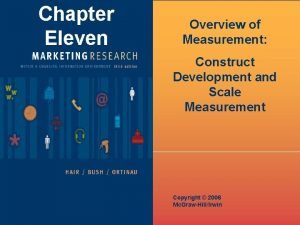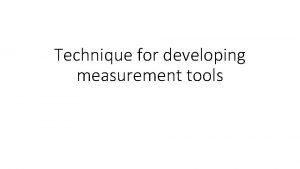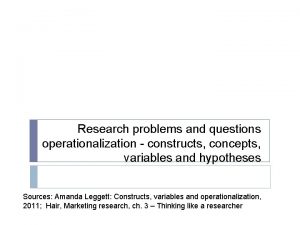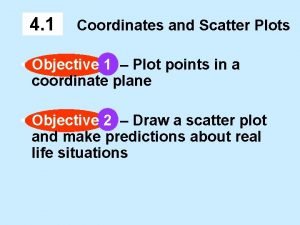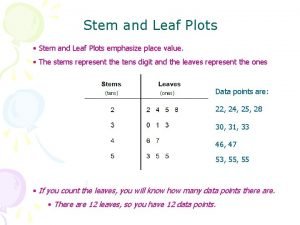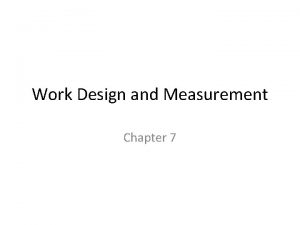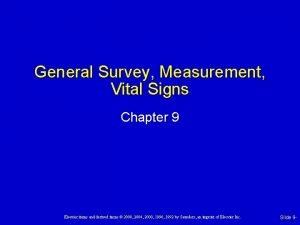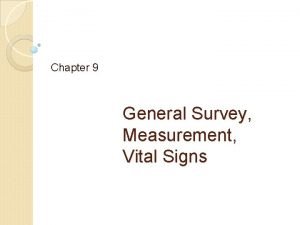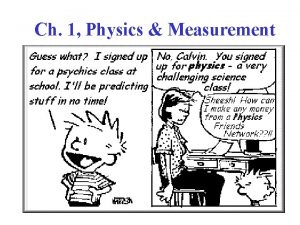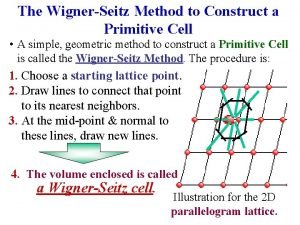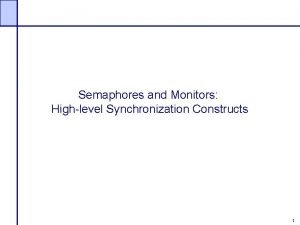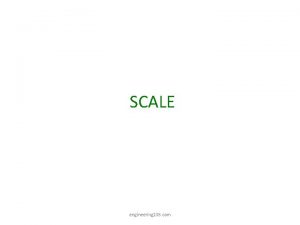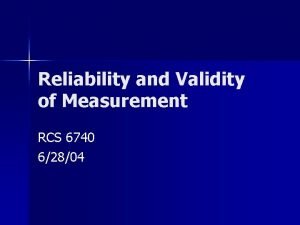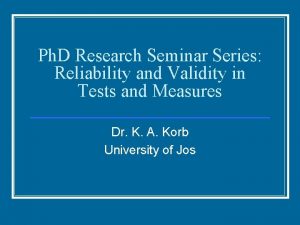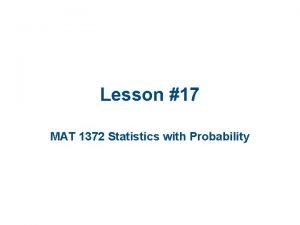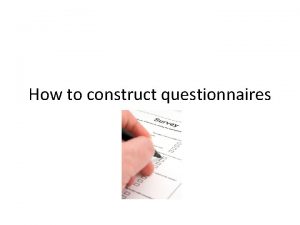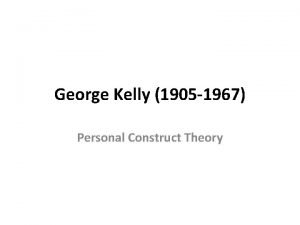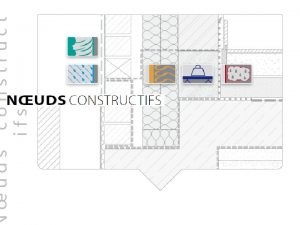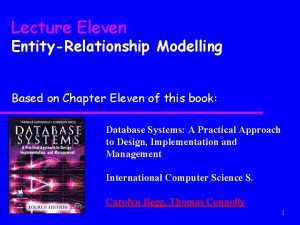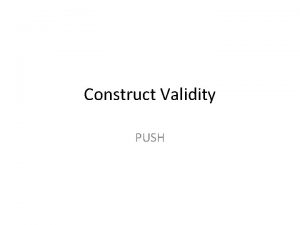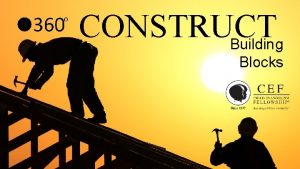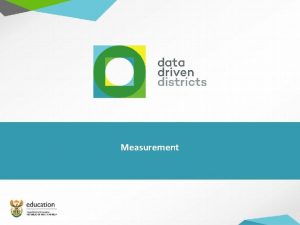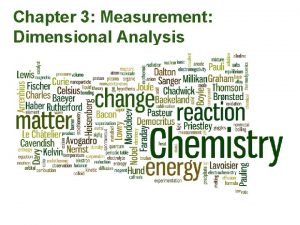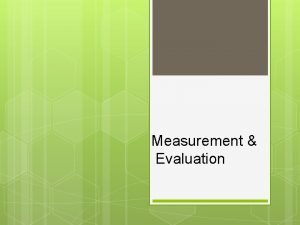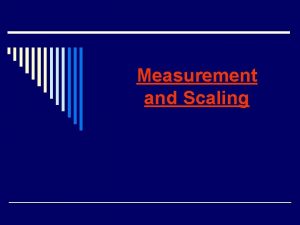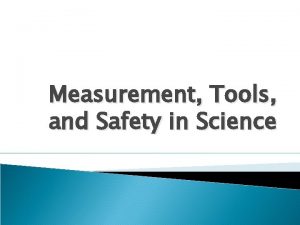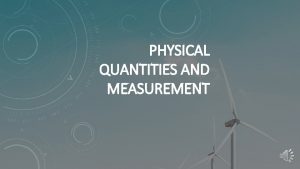Chapter Eleven Overview of Measurement Construct Development and





































- Slides: 37

Chapter Eleven Overview of Measurement: Construct Development and Scale Measurement Copyright © 2006 Mc. Graw-Hill/Irwin

Learning Objectives 1. Explain what constructs are, how they are developed, and why they are important to measurement and scale designs. 2. Discuss the integrated validity and reliability concerns underlying construct development and scale measurement. 3. Explain what scale measurement is, and describe how to correctly apply it in collecting raw data from respondents. Mc. Graw-Hill/Irwin 2

Learning Objectives 4. Identify and explain the four basic levels of scales and discuss the amount of information they can provide a researcher or decision maker. 5. Discuss the hybrid ordinally-interval scale design and the types of information it can provide researchers. 6. Discuss three components of scale development and explain why they are critical to gathering primary data. Mc. Graw-Hill/Irwin 3

Overview of the Measurement Process Explain what constructs are, how they are developed, and why they are important to measurement ad scale designs • Measurement – Process of determining the amount of information about persons, events, ideas, and/or objects of interest and their relationship to business problems or opportunities Mc. Graw-Hill/Irwin 4

Overview of the Measurement Process Explain what constructs are, how they are developed, and why they are important to measurement ad scale designs • Assign numbers or label to – People’s thoughts, feelings, behaviors and characteristics – Features or attributes of objects – Aspect of ideas Mc. Graw-Hill/Irwin 5

Overview of the Measurement Process Explain what constructs are, how they are developed, and why they are important to measurement ad scale designs • Construct Development – Precisely identifying and defining what’s to be measured • Scale Measurement – How to precisely measure each construct Mc. Graw-Hill/Irwin 6

Overview of the Measurement Process Explain what constructs are, how they are developed, and why they are important to measurement ad scale designs • Object – Any tangible item in a person’s environment that can be clearly and easily identified through his or her senses • Construct – Hypothetical variable made up of a set of component responses or behaviors that are thought to be related Mc. Graw-Hill/Irwin 7

Overview of the Measurement Process Explain what constructs are, how they are developed, and why they are important to measurement ad scale designs • Construct development – an integrative process in which researchers determine what specific data should be collected for solving the defined research problem • Accurate identification of what should be investigated requires – Knowledge and understanding of constructs – Knowledge of dimensionality – Knowledge of validity – Knowledge of operationalization Mc. Graw-Hill/Irwin 8

Overview of the Measurement Process Explain what constructs are, how they are developed, and why they are important to measurement ad scale designs • Heart of Construct Development – the need to determine exactly what is to be measured 1. Objects that are relevant are identified first 2. The objective and subjective properties of each object are specified 3. Concreteness of an object–limited to measuring the object’s objective properties 4. Object’s subjective properties–measurable subcomponents that can be used to clarify the abstractness associated with the object’s subjective properties Mc. Graw-Hill/Irwin 9

Overview of the Measurement Process • Explain what constructs are, how they are developed, and why they are important to measurement ad scale designs Determining What Is to Be Measured – the need to acquire relevant, high-quality data to support management’s decisions 1. Domain of observables –portfolio of identifiable and measurable components associated with an abstract construct 2. This preliminary information gathered from secondary research and exploratory research such as focus groups is then used as a guideline for collecting data from a more representative sample about attributes Mc. Graw-Hill/Irwin 10

Overview of the Measurement Process • Discuss the integrated validity and reliability concerns underlying construct development and scale measurement Assessing the Validity of the Construct – an after-the-fact activity–after creating the scale, collecting the data, then the researcher performs the statistical analyses 1. 2. 3. 4. Mc. Graw-Hill/Irwin Content validity (also called “face” validity) Convergent validity Discriminant validity Nomological validity 11

Overview of the Measurement Process Discuss the integrated validity and reliability concerns underlying construct development and scale measurement • Approaches Used to Collect Data for Assessing Construct Validity – Pilot study • Using 50 people who represent the defined target population • Using a panel of experts—independently judge the dimensionality of the construct • Inappropriate Scale Measurement Formats – After-the-fact data – Direct cognitive structural analysis – Scale reliability Mc. Graw-Hill/Irwin 12

Overview of the Measurement Process Discuss the integrated validity and reliability concerns underlying construct development and scale measurement • Inappropriate set of respondents – Using college students to represent the population as a whole – Using college students in construct development–drawn using a convenience sampling approach • Construct Operationalization – Operationalization • explaining a construct’s meaning in measurement terms by specifying the activities or operations necessary to measure it. – The process focuses on the design and use of questions and scale measurements to gather the needed data Mc. Graw-Hill/Irwin 13

Exhibit 11. 2 Mc. Graw-Hill/Irwin Discuss the integrated validity and reliability concerns underlying construct development and scale measurement 14

Basic Concepts of Scale Measurement Explain what scale measurement is, and describe how to correctly apply it in collecting raw data from respondents • Types of Data Collected in Research Practices – State-of-Being Data – State-of-Mind Data – State-of-Behavior Data – State-of-Intention Data Mc. Graw-Hill/Irwin 15

Basic Concepts of Scale Measurement Explain what scale measurement is, and describe how to correctly apply it in collecting raw data from respondents • Scale Measurement – process of assigning descriptors to represent the range of possible responses to a question about a particular object or construct • The quantity and quality of the responses associated with any question or observation technique depend directly on the scale measurements used by the researcher • The focus is on measuring the existence of various characteristics of person’s response • Scale measurement directly determines the amount of raw data that can be ascertained from a given questioning or observation method • Scale Points – designated degrees of intensity assigned to the responses in a given questioning or observation method Mc. Graw-Hill/Irwin 16

Exhibit 11. 3 Mc. Graw-Hill/Irwin Explain what scale measurement is, and describe how to correctly apply it in collecting raw data from respondents 17

Basic Concepts of Scale Measurement Explain what scale measurement is, and describe how to correctly apply it in collecting raw data from respondents • Properties of Scale Measurements – Assignment Property – Order Property • 3 relationships between responses A and B – A>B – A<B – A=B – Distance Property – Origin Property • Each scaling property builds on the pervious one Mc. Graw-Hill/Irwin 18

Exhibit 11. 4 Mc. Graw-Hill/Irwin Identify and explain the four basic levels of scales and the amount of information they can provide 19

Basic Types of Scales Identify and explain the four basic levels of scales and the amount of information they can provide • Nominal Scales – type of scale in which the questions require respondents to provide only some type of descriptor as the raw response • Ordinal Scales – allows a respondent to express relative magnitude between the answers to a question Mc. Graw-Hill/Irwin 20

Exhibit 11. 5 Mc. Graw-Hill/Irwin Identify and explain the four basic levels of scales and the amount of information they can provide 21

Exhibit 11. 6 Mc. Graw-Hill/Irwin Identify and explain the four basic levels of scales and the amount of information they can provide 22

Basic Types of Scales Identify and explain the four basic levels of scales and the amount of information they can provide • True Class Interval Scales – demonstrate the absolute differences between each scale point • Hybrid Ordinally-Interval Scale – an ordinal scale that is artificially transformed into an interval scale by the researcher • Primary scale point descriptors • Secondary scale descriptors Mc. Graw-Hill/Irwin 23

Exhibit 11. 7 Mc. Graw-Hill/Irwin Identify and explain the four basic levels of scales and the amount of information they can provide 24

Basic Types of Scales Identify and explain the four basic levels of scales and the amount of information they can provide • Ratio Scales– – the researcher can identify the absolute differences, not only between each scale point but also to make comparisons between the raw responses • Enable a “true natural zero” or “true state of nothing” response to be a valid raw response to the question • Ratio scales requests that respondents provide a specific numerical value as their response, regardless of whether or not a set of scale points is used Mc. Graw-Hill/Irwin 25

Exhibit 11. 9 Mc. Graw-Hill/Irwin Identify and explain the four basic levels of scales and the amount of information they can provide 26

Development and Refinement of Scaling Measurements Discuss three components of scale development and explain why they are critical to gathering primary data • Key to Designing High-quality Scales – Understanding the defined problem – Establishing detailed data requirements – Identifying and developing the constructs – A complete measurement scale consists of three critical components • The question • The attribute • The scale point description • Development of the constructs Mc. Graw-Hill/Irwin 27

Exhibit 11. 10 Mc. Graw-Hill/Irwin Discuss three components of scale development and explain why they are critical to gathering primary data 28

Exhibit 11. 11 Key Criteria in Scale Development Mc. Graw-Hill/Irwin Discuss three components of scale development and explain why they are critical to gathering primary data 29

Development and Refinement of Scaling Measurements Discuss three components of scale development and explain why they are critical to gathering primary data • Criteria for Scale Development – Intelligibility of the Questions – Appropriateness of Primary Scale Descriptors – Discriminatory Power of the Scale Descriptors Mc. Graw-Hill/Irwin 30

Development and Refinement of Scaling Measurements Discuss three components of scale development and explain why they are critical to gathering primary data – Reliability of the Scale • Scale reliability – Test-retest – Equivalent Form – Internal consistency » Split-half tests » Coefficient alpha Mc. Graw-Hill/Irwin 31

Development and Refinement of Scaling Measurements Discuss three components of scale development and explain why they are critical to gathering primary data – Balancing positive/negative scale descriptors – Inclusion of a neutral response choice • Forced-choice scale • Free-choice scale Mc. Graw-Hill/Irwin 32

Exhibit 11. 12 Mc. Graw-Hill/Irwin Discuss three components of scale development and explain why they are critical to gathering primary data 33

Development and Refinement of Scaling Measurements Discuss three components of scale development and explain why they are critical to gathering primary data • Measures of Central Tendency – Mean – Median – Mode • Measures of Dispersions – Frequency Distribution – Ranges – Sample standard deviations Mc. Graw-Hill/Irwin 34

Exhibit 11. 13 Mc. Graw-Hill/Irwin Discuss three components of scale development and explain why they are critical to gathering primary data 35

Summary • Value of Measurement within Information Research • Overview of the Measurement Process • Basic Concepts of Scale Measurement • Basic Levels of Scales • Development and Refinement of Scaling Measurements Mc. Graw-Hill/Irwin 36

The End Copyright © 2006 Mc. Graw-Hill/Irwin 37
 Construct development
Construct development Game development with construct 2
Game development with construct 2 Chapter 17 overview elements and their properties
Chapter 17 overview elements and their properties Development measurement tools
Development measurement tools Construct in research
Construct in research A student used a compass and a straightedge to construct ce
A student used a compass and a straightedge to construct ce 4-1 construct and interpret scatter plot
4-1 construct and interpret scatter plot What is stem-and-leaf plot
What is stem-and-leaf plot Chapter 24 trauma overview
Chapter 24 trauma overview Chapter 14 medical overview
Chapter 14 medical overview Chapter 9 lesson 2 photosynthesis an overview
Chapter 9 lesson 2 photosynthesis an overview Chapter 12 selling overview
Chapter 12 selling overview Financial intermediaries
Financial intermediaries Chapter 1 overview of verb tenses
Chapter 1 overview of verb tenses Overview of personal finance chapter 1
Overview of personal finance chapter 1 Tooth numbering system in usa
Tooth numbering system in usa Foundations in personal finance chapter 1 review
Foundations in personal finance chapter 1 review General features of animals
General features of animals Chapter 1 an overview of financial management
Chapter 1 an overview of financial management Chapter 1 overview of financial statement analysis
Chapter 1 overview of financial statement analysis Work design and measurement
Work design and measurement Measurement elsevier
Measurement elsevier Blood pressure child normal range
Blood pressure child normal range Unit of measurement for power
Unit of measurement for power Measurement 1 physics
Measurement 1 physics Personality construct examples
Personality construct examples Tools and materials needed
Tools and materials needed Wigner-seitz cell
Wigner-seitz cell Appearance of the tainos
Appearance of the tainos Personal construct examples
Personal construct examples Is high level synchronization construct
Is high level synchronization construct Engineering 108.com
Engineering 108.com Construct validity meaning
Construct validity meaning What is content validity
What is content validity Parallel line construction
Parallel line construction Construct the sampling distribution of the sample means
Construct the sampling distribution of the sample means How to construct a survey
How to construct a survey Personal construct theory george kelly
Personal construct theory george kelly
